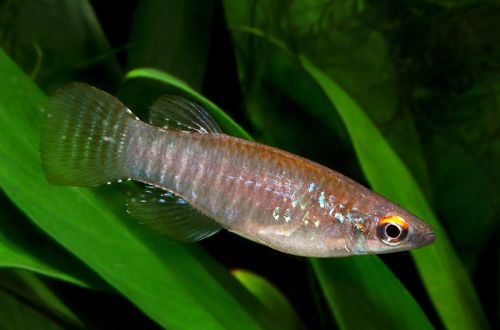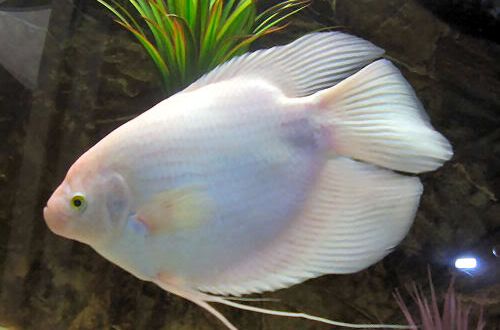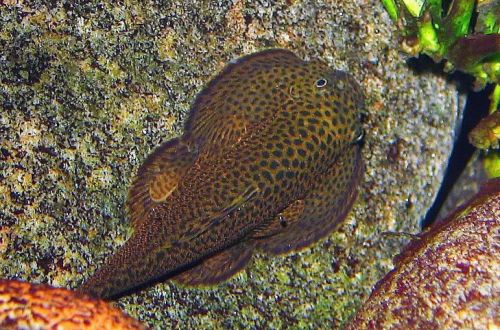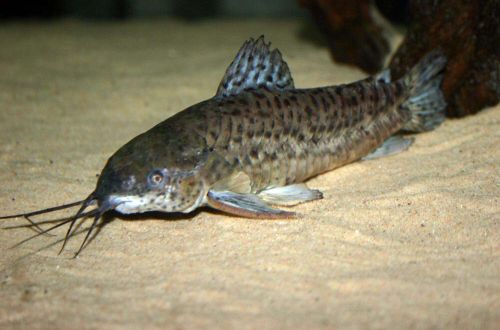
Aploheilichthys spilauchen
Aplocheilichthys spilauchen, scientific name Aplocheilichthys spilauchen, belongs to the Poeciliidae family. A small slender and beautiful fish, has an original color. Favorably looks in shaded aquariums with a dark substrate. Often mistakenly marketed as a freshwater fish, however, it actually prefers brackish water.

As you can see from the name, this is the Russian pronunciation of the scientific name (lat. language). In other countries, in particular in the USA, this fish is referred to as Banded Lampeye, which in free translation means “Lamellar Lampeye” or “Lamellar Killy Fish with Light Bulb Eyes”. This and similar species really have a unique feature – expressive eyes with a bright point.
The brackish water fish are also carnivorous, which makes them very demanding to care for, so they are not recommended for beginner aquarists.
Contents
Habitat
They are found in the brackish coastal waters of West Africa (Cameroon, Angola, Senegal, Nigeria), for example, at the mouths of the Kwanza and Senegal rivers. Fish can both rise upstream and end up in sea water, but this is extremely rare. Aploheilichthys spilauchen is not a migratory species. In nature, it feeds on insect larvae, small aquatic insects, crustaceans, river worms.
Description
The fish are small in size up to 7 cm, the body is elongated cylindrical with short fins. The head has a somewhat flattened top view. The coloration is creamy light brown with iridescent silver-blue vertical stripes in the front. In males, the stripes are clearly visible at the base of the tail, in addition, the fins have more intense colors.
Food
It is a carnivorous species, it feeds exclusively on protein foods. In a home aquarium, you can serve live or fresh frozen foods such as bloodworms, fly or mosquito larvae, brine shrimp for young fish.
Maintenance and care
They are considered quite hardy in their habitat, which cannot be said about closed systems of aquariums. They require very clean water, so it is recommended to purchase a productive filter and replace part of the water (at least 25%) once a week. Other minimum necessary equipment consists of a heater, lighting system, aerator.
Despite the fact that Aploheilichthys spilauchen is able to live in fresh water, however, this can reduce its immunity and increase the risk of diseases. Optimum conditions are achieved in brackish water. For its preparation, you will need sea salt, which is diluted in a proportion of 2-3 teaspoons (without a slide) for every 10 liters of water.
In the design, imitation of the natural habitat looks preferable. Dark substrate (coarse sand or small pebbles) with dense vegetation located in groups along the side and back wall of the tank. The lighting is subdued.
Social behavior
Peaceful and friendly schooling fish, get along well with other peaceful species or their own kind. Active or large fish can pose a real threat, they can intimidate the shy Aplocheilichthys, and this is fraught with serious consequences, ranging from stress to refusal to eat.
Sexual differences
Males have a more arched back, richer coloration, transverse stripes are observed not only in the front of the body, but also closer to the base of the tail.
Breeding / breeding
Successful breeding at home is quite problematic and requires some experience. Spawning is possible in a common species aquarium, if representatives of other species are present, then the couple is transplanted into a separate tank. The stimulus for the mating season is the gradual establishment of the following conditions: the water level drops no higher than 16–18 cm, the water is brackish, soft (5 ° dH), slightly acidic (pH 6,5), temperature in the range of 25–27 ° С. Thin-leaved plants are required in the design.
After a short courtship procedure, spawning occurs, the female attaches the eggs to the plants, and the male fertilizes them. Then they return to the community tank, otherwise the eggs will be eaten by their own parents. In a situation where the process took place in a general aquarium, the plants with eggs should be moved to a separate spawning aquarium with similar water parameters.
The fry appear after 15 days, feed the ciliates with shoes. Keep a close eye on the condition of the water, which quickly becomes contaminated from such a diet.
Diseases
Fish are resistant to many common diseases, provided they are kept in the right conditions. Problems can occur in fresh water, poor quality food or simply poor nutrition, etc. For more information on symptoms and treatments, see Aquarium Fish Diseases.





